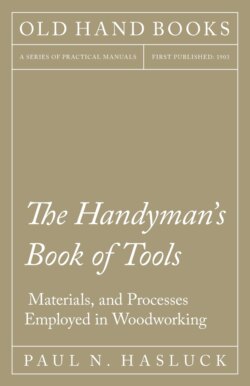Читать книгу The Handyman's Book of Tools, Materials, and Processes Employed in Woodworking - Paul N. Hasluck - Страница 54
На сайте Литреса книга снята с продажи.
HOW CHISEL EDGES SHOULD BE SHAPED.
ОглавлениеEdge tools used in wood working are more sensitive to ill-treatment than those used for working metal, and of the latter those which are operated by hand are relatively more sensitive than those that are actuated by machine, the reason being, of course, that the more delicate the nature of the work, the more readily is the action of the tool felt. Many tools in daily use in factory machines are badly formed, so causing a great waste of power that could not be tolerated if they were hand worked, owing to the excess of energy required. In many cases, tools do not cut, or they cut badly, because the wedge form is impaired. The chisel, and all chisel-like tools, should be ground with one facet only, not with several. This applies alike to the chisel for wood working and that for metal cutting, to the gouge, the axe, adze, knife, razor, plane-iron, spokeshave, and others. The reason why it must be so in order to develop the full efficiency of these tools is apparent from the accompanying illustrations. Thus, comparing Figs. 141 and 142, which are slightly exaggerated for the purpose of illustration, the former shows how a chisel-like tool ought to be ground, the concavity of the facet exactly corresponding with the curve of the stone upon which it is ground. Such grinding requires some practice in the case of broad chisels and plane-irons, the tendency in unskilful hands being to produce a succession of facets like Fig. 142, due to the slipping up and down of the tool on the revolving stone. But the advantages of the form shown by Fig. 141 are very great. First, the necessity for regrinding is delayed much longer than in Fig. 142, where the facet is on the whole convex instead of concave. Fig. 141 approaches to the hollow razor form (Fig. 143), and for some little time the grinding angle and the sharpening angle will coincide; after awhile it becomes necessary to tip the facet in sharpening (see Fig. 144), and the sharpening angle is gradually rendered more obtuse until regrinding becomes necessary. But in Fig. 142 the sharpening angle is obtuse from the beginning, and regrinding soon is necessary. Moreover, since the angle is so obtuse, a greater expenditure of energy than in the former case is necessary to remove the shavings, there being less penetrative power. This is apparent from the dotted lines, which show the effective angles of the two by comparison. The endeavour, then, should be to preserve the wedge-like form of a tool edge as long as possible, the grinding of the hollow facet being regarded as of the greatest importance. Chisels are often badly sharpened by tilting up the face for the purpose of turning back the wire edge. The result is that the face is like Fig. 145. This again detracts from the wedge form. Worse than that, it destroys the guidance afforded by a perfectly flat face, this being a very important point. The chisel must be tilted before it will cut, and there is no longer that contact of broad faces which is conducive to the guidance of the tool, and the difficulty of cutting surfaces and ends is much increased. No matter how flat the general area of the chisel face is, if there is a second facet, however narrow at the cutting edge, that determines the action of the tool. The tool angle is measured between that and the sharpened facet on the bevelled face. Of course, with all tools the labour of cutting is increased as the wedge form becomes impaired by legitimate wear, that is as their angles become more obtuse. When the amount of this is slight only, the tools need sharpening; but when, by repeated sharpening, the tool angle becomes very obtuse, grinding is necessary to remove material in greater quantity. The grinding and sharpening of chisels are operations practically identical with grinding and sharpening plane irons (see pp. 54 and 55). Fig. 146, however, shows the position in which the chisel is held on the oilstone.
Fig. 139.—Sash Mortise Chisel.
Fig. 140.—Socket Lock Mortise Chisel.
Fig. 141.—Correctly Shaped Chisel Edge.
Fig. 142.—Incorrectly Shaped Chisel Edge.
Fig. 143.—Section of Hollow-ground Razor.
Fig. 144.—Obtuse Angle of Old Chisel Edge.
Fig. 145.—Badly Sharpened Chisel Edge.
Fig. 146.—Sharpening Chisel on Oilstone.
